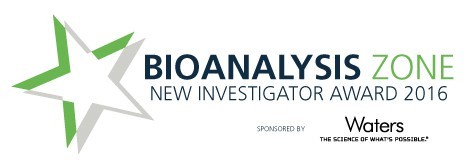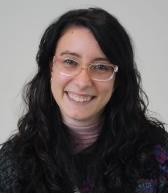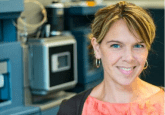2016 New Investigator: Isabel Álvarez-Martos

 Nominee:
Nominee:
Nominated By:
Supporting Comments:
What made you choose a career in bioanalysis?
There are over 50 million people worldwide suffering from neurodegenerative diseases and the economic costs are correspondingly large, about $650 billion. The need for low cost, good quality, high-throughput point-of-care-devices that can be used for diagnosis at a very early stage, and maybe facilitate the way people live, has motivated me to pursue a career in bioanalysis.
Describe the main highlights of your bioanalytical research, and its importance to the bioanalytical community.
My PhD research aimed to develop point-of-use electroanalytical devices, i.e. portable, easy to use, and capable of operating with little supporting equipment. This is of paramount importance not only for point-of-care diagnosis, but also for drug, food or environmental testing and monitoring. Later on I also became interested in the search of new amplification strategies. For example, using dendrimers as a wire for proteins and DNA. These tree-like, highly branched nanostructures can be used to improve sensitivity either by loading a large number of target molecules or catalytic redox-recycling amplification.
At the moment the focus of my research is to provide efficient biosensor tools for the selective and sensitive real-time monitoring of dopamine, and by this contributing to the development of novel diagnostic principles for disease monitoring and drug targeting. This is crucial for both fundamental studies of mechanisms underlying Parkinson’s disease and pharmacological industrial research aimed at optimizing the effects of pharmacological agents on neurotransmitters levels. Therefore, assisting the targeting and development of drugs for treatment of severe neurological and psychiatric diseases.
What is the impact of your work beyond your home laboratory?
The interest of the work within the scientific community is supported, for example, by the invitation to give oral presentations at international conferences and poster awards (two times last year).
In order for any research to have an impact in the world it must be disseminated to a broad audience. In this sense, I have tried to make my research more accessible for everyone. For instance by providing open access through data repositories, articles in local newspapers or interviews in regional TV programs.
I tried to contribute to science learning by writing a book chapter in the textbook Fernandez-Abedul MT, Alvarez-Martos I, Alonso FJG, Costa-Garcýa A. Improving the separation in microchip electrophoresis by surface modification. In: Capillary electrophoresis and microchip capillary electrophoresis: principles, applications, and limitations. Garcia CD, Chumbimuni-Torres KY, Carrilho E (Eds). John Wiley & Sons, Inc., NJ, USA 95–120 (2013).
Emphasis was put on establishing collaboration between disciplines, international institutions and industry. This has resulted in an already successful european project application with an industrial partner, MicruX Technologies (Oviedo, Spain) – one (out of three) spin-off companies from the research group where I did my PhD.
Describe the most difficult challenge you have encountered in the laboratory and how you overcame it.
Initially I was completely overwhelmed by public speaking. Therefore I focused my efforts on preparing my presentations as much as I could and rehearsals with my lab mates. I should thank them for giving me feedback on my talks, for their patience and for letting me practise for them countless times.
My research has involved a lot of interdisciplinary work and thus, a considerable challenge was to work (and write papers) from outside my scientific background in analytical chemistry. First, I needed to read and understand not so familiar content (e.g., methods of organic synthesis, NMR, XPR and SEM characterization techniques, carbon nanotubes synthesis methods, photolithographic techniques…) and second, I had to communicate this content in an understandable way to people with such different backgrounds as physicists, material scientists or medical doctors. To overcome it I read a lot of literature, I asked for advice from specialists in the field at my workplace and I visited international laboratories with the necessary expertise. This overall experience has showed me how amazing is to learn new things and given me the capability to solve what at the beginning seemed to be huge challenges.
Describe your role in bioanalytical communities/groups.
I have been very active in contributing to the bioanalytical scientific community. For example, I participated in the organizing tasks of the XXXII Biannual Congress organized by the Spanish Royal Society of Chemistry in 2009 and I was in the organizing committee of the II International Workshop on Analytical Miniaturization in 2010.
I am also an active member of the following:
- Scientific associations: Spanish Royal Society of Chemistry, Young Chemistry Researchers (part of the European Young Chemist Network) and the International Society of Electrochemistry (division 1-analytical electrochemistry and division 2-bioelectrochemistry).
- International not-for-profit associations: Marie Curie Alumni Association (provides a virtual meeting place and communication tools for networking, discussion and knowledge exchange) and the Spanish Researchers in Denmark (promotes dissemination of the research carried out by their members, as well as collaboration between scientific institutions in Spain and Denmark).
Since 2014 I have been a regular referee of Electrochimica Acta (impact factor 4.504).
Please list up to five of your publications in the field of bioanalysis:
- Álvarez-Martos I, Ferapontova EE. Electrochemical label-free aptasensor for specific analysis of dopamine in serum in the presence of structurally related neurotransmitters. Chem. 88, 3608–3616 (2016).
- Castaing V, Álvarez-Martos I, Ferapontova EE. Wiring of glucose axidizing FAD-dependent enzymes by methylene blue-modified G3-PAMAM dendrimers attached to spectroscopic graphite electrodes. Acta 197, 263–272 (2016).
- Álvarez-Martos I, Alonso-Bartolomé R, Hernández VM et al. Poly(glycidyl methacrylate) derivatives as modifiers in microfluidic devices for the improvement of catecholamines separation. Funct. Polym 100, 89–96 (2016).
- Álvarez-Martos I, Campos R, Ferapontova EE. Surface state of the dopamine RNA aptamer affects specific recognition and binding of dopamine by the aptamer-modified electrodes. Analyst 140, 4089–4096 (2015).
- Álvarez-Martos I, Fernández-Abedul MT, Anillo A, García-Fierro JL, García-Alonso FJ, Costa-García A. Poly(acrylic acid) microchannel modification for the enhanced resolution of catecholamines microchip electrophoresis with electrochemical detection. Chim. Acta 724, 136–143 (2012).
Please select one publication from above that best highlights your career to date in the field of bioanalysis and provide an explanation for your choice.
I choose publication 1 because it perfectly summarizes what my line of research has been since I became a scientist and because it also represents a holy grail in neuroscience – dopamine analysis in the presence of structurally related neurotransmitters. In this work we showed a RNA aptamer-based sensor which allows rapid, sensitive and specific biorecognition of dopamine with capability to operate in biological fluids. This platform of analysis can then contribute to in vivo electroanalysis of neurodegenerative diseases, assisting in revealing, e.g., the pathways and mechanisms of amyloidosis in brain and to in vitro screening of drug-administered Parkinson’s patients.
Find out more about this year’s New Investigator Award, the prize, the judging panel and the rest of our nominees.


